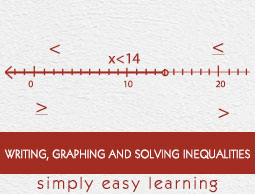
- Writing, Graphing and Solving Inequalities
- Home
- Translating a Sentence by Using an Inequality Symbol
- Translating a Sentence into a One-Step Inequality
- Introduction to Identifying Solutions to an Inequality
- Writing an Inequality for a Real-World Situation
- Graphing a Linear Inequality on the Number Line
- Writing an Inequality Given a Graph on the Number Line
- Identifying Solutions to a One-Step Linear Inequality
- Additive Property of Inequality with Whole Numbers
- Multiplicative Property of Inequality with Whole Numbers
- Solving a Two-Step Linear Inequality with Whole Numbers
- Solving a Word Problem Using a One-Step Linear Inequality
Additive Property of Inequality with Whole Numbers
Introduction
The Additive property of Inequality states that, for any three numbers a, b, and c.
If a > b, then a + c > b + c
If a > b, then a c > b c
Lets start with the simple inequality a > b. If we want to add a quantity c to the left side, we also have to add it to the right side in order to keep the inequality true. We can write this property as
If a > b, then a + c > b + c.
Similarly, if we want to subtract a quantity c from the left side, we also have to subtract it from the right side in order to keep the inequality true. We can write this property as −
If a > b, then a c > b c.
We show one good real-life example to model this property. For instance, suppose that you know two sisters: Angela and Serena. You know that Angela is older than Serena.
So Angelas age > Serenas age.
In say 5 years from now, will Angela still be older than Serena? Of course! Since the sisters are aging the same amount. In algebraic way, you could represent this inequality as −
Angelas age + 5 years > Serenas age + 5 years
Similarly, the inequality comparing the sisters ages 3 years prior to present time would be
Angelas age 3 years > Serenas age 3 years
Example 1
Solve the following using the additive property of inequality −
x 12 > 9
Solution
Step 1:
Given x 12 > 9; using additive property of inequality
We add 12 to both sides
x + 12 12 > 9 + 12; x > 21
Step 2:
So, the solution for the inequality is x > 21
Example 2
Solve the following using the additive property of inequality −
8 x ≥ 13
Solution
Step 1:
Given 8 x ≥ 13; using additive property of inequality
We subtract 8 from both sides
8 x 8 ≥ 13 8; x ≥ 5
Step 2:
Dividing both sides by 1, we get x ≤ 5 after flipping the inequality sign as well.
So, the solution for the inequality is x ≤ 5